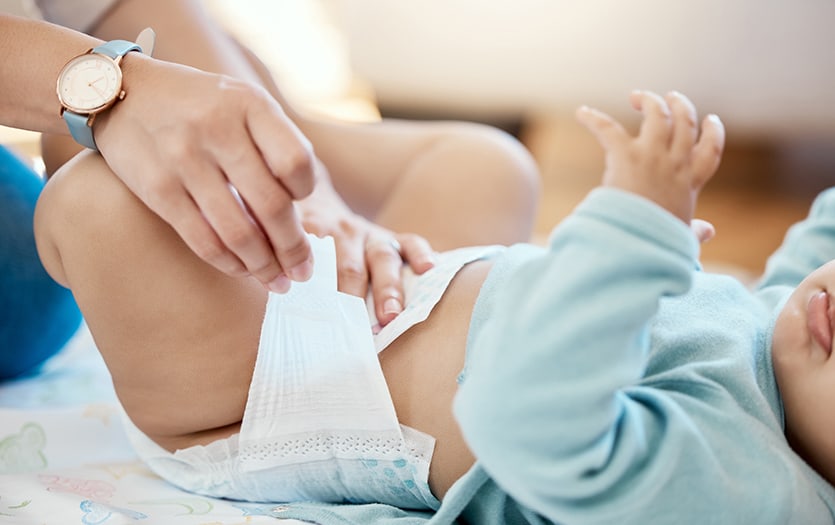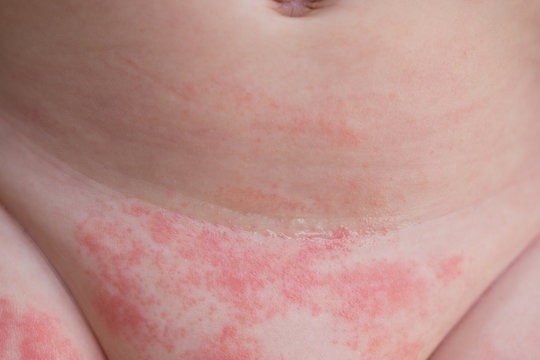Witch hazel is a natural remedy that has been used for centuries to treat a variety of skin conditions. One of its lesser-known uses is for the treatment of diaper rash in babies.
Diaper rash is a common condition that affects many babies and can cause discomfort and irritation. While there are many treatments available for diaper rash, some parents prefer to use natural remedies like witch hazel.
Understanding diaper rash is important for parents to be able to identify and treat the condition. Diaper rash is a red, irritated rash that appears on the skin under a baby’s diaper. It is caused by a combination of moisture, friction, and bacteria.
While diaper rash is not usually serious, it can be uncomfortable for babies and may lead to other skin infections. There are several common treatments for diaper rash, including creams, ointments, and powders. However, some parents prefer to use natural remedies like witch hazel, which is known for its anti-inflammatory and astringent properties.
Key Takeaways
- Witch hazel is a natural remedy that can be used to treat diaper rash in babies.
- Diaper rash is a common condition that is caused by moisture, friction, and bacteria.
- While there are many treatments available for diaper rash, some parents prefer to use natural remedies like witch hazel.
Understanding Diaper Rash

Diaper rash is a common skin condition that affects infants and toddlers. It is characterized by redness, inflammation, and sores in the diaper area. Diaper rash can cause discomfort and pain for the child, and it can be a source of concern for parents.
There are several causes of diaper rash, including prolonged exposure to wetness, friction from the diaper, and irritation from stool or urine. Diaper dermatitis, which is a type of diaper rash caused by a combination of factors, is the most common form of diaper rash.
In some cases, diaper rash can be caused by a yeast infection. Yeast rash is characterized by redness, inflammation, and small red bumps. It can be difficult to treat and may require antifungal medication.
Allergies and sensitive skin can also contribute to diaper rash. Some babies may be allergic to certain ingredients in diapers, wipes, or creams. Others may have sensitive skin that is easily irritated by these products.
Symptoms of diaper rash may include redness, inflammation, and small red bumps. In more severe cases, the skin may become raw and develop sores. The child may also experience discomfort and pain in the affected area.
To prevent diaper rash, it is important to change the child’s diaper frequently and to use a diaper cream to protect the skin. It is also important to avoid using products that may irritate the skin, such as scented wipes or harsh soaps.
In summary, diaper rash is a common skin condition that can be caused by a variety of factors, including prolonged exposure to wetness, friction from the diaper, and irritation from stool or urine. It can also be caused by allergies, sensitive skin, and yeast infections.
Symptoms may include redness, inflammation, and small red bumps. To prevent diaper rash, it is important to change the child’s diaper frequently and to use a diaper cream to protect the skin.
Common Treatments for Diaper Rash
1. Over-the-Counter Products
When it comes to treating diaper rash, there are several over-the-counter products available that can help alleviate symptoms. These products are generally safe and effective for mild to moderate cases of diaper rash. Some examples of over-the-counter products include:
- Creams and ointments: Diaper rash creams and ointments are designed to soothe and protect the skin. They typically contain ingredients like zinc oxide or petroleum jelly, which help create a barrier between the skin and moisture.
- Zinc oxide paste: Zinc oxide paste is a thick, white paste that can be applied directly to the affected area. It helps soothe and protect the skin, and can also help reduce inflammation.
- Antifungal cream: If the diaper rash is caused by a yeast infection, an antifungal cream like Lotrimin may be recommended. These creams are designed to kill the fungus that is causing the infection.
2. Prescription Treatments
For more severe cases of diaper rash, prescription treatments may be necessary. These treatments are typically reserved for cases that do not respond to over-the-counter products. Some examples of prescription treatments include:
- Hydrocortisone ointment: Hydrocortisone ointment is a steroid cream that can help reduce inflammation and itching. It should only be used under the guidance of a healthcare provider, as overuse can lead to skin thinning and other side effects.
- Medications: In some cases, a healthcare provider may prescribe an oral medication to help treat the diaper rash. These medications are typically reserved for cases of severe diaper rash that do not respond to other treatments.
It’s important to note that some diaper rash creams, like Balmex, Desitin, and Triple Paste, are available in both over-the-counter and prescription strengths. If over-the-counter treatments are not providing relief, a healthcare provider may recommend a prescription-strength version of one of these products.
Overall, there are several treatment options available for diaper rash. It’s important to speak with a healthcare provider if the rash is severe or does not respond to over-the-counter treatments.
Role of Witch Hazel in Diaper Rash Treatment
Witch hazel has been used for centuries as a natural remedy for various skin conditions, including diaper rash. It is a natural astringent that helps to soothe and heal the skin and has anti-inflammatory properties that help to reduce redness and irritation.
One of the main benefits of using witch hazel for diaper rash is its ability to clean and dry the affected area. This is important because moisture can exacerbate diaper rash and make it more difficult to treat. Witch hazel helps to remove excess moisture from the skin, making it easier to keep the affected area clean and dry.
In addition to its astringent properties, witch hazel also has healing properties that can help to speed up the healing process. It contains tannins, which are compounds that help to tighten and strengthen the skin, making it more resistant to further irritation.
When using witch hazel for diaper rash, it is important to choose a product that is free from alcohol and other harsh chemicals that can further irritate the skin. It is also important to use it in conjunction with other treatments, such as diaper rash creams, to ensure the best possible outcome.
Overall, witch hazel can be a useful addition to a diaper rash treatment regimen. Its astringent and anti-inflammatory properties make it an effective way to soothe and heal irritated skin, while its ability to clean and dry the affected area helps to prevent further irritation.
Preventive Measures for Diaper Rash
Preventing diaper rash is always better than treating it. Here are some preventive measures that can help avoid diaper rash:
1. Clean and Dry
Keeping the diaper area clean and dry is the most effective way to prevent diaper rash. Change the diaper frequently, at least every two hours, and immediately after bowel movements. Use a gentle cleanser and warm water to clean the area, and pat it dry with a soft cloth or towel.
2. Airflow
Allowing the diaper area to breathe can help prevent diaper rash. Let your baby go diaper-free for a few minutes each day, or use a breathable diaper. Avoid tight-fitting clothes and diapers that can trap moisture.
3. Disposable Diapers
Disposable diapers are more absorbent than cloth diapers, and they can help keep the skin dry. Choose a diaper that fits well and has an absorbent gel core. Change the diaper frequently, and avoid using scented wipes, lotions, or powders.
4. Cloth Diapers
If you prefer to use cloth diapers, make sure they are clean and dry. Use a detergent that is free of fragrances and dyes, and rinse the diapers thoroughly. Change the diaper frequently, and use a diaper rash cream if necessary.
5. Wipes
Choose fragrance-free wipes that are gentle on the skin. Avoid wipes that contain alcohol or other harsh chemicals. Use a clean wipe for each diaper change, and pat the area dry with a soft cloth or towel.
6. Lotion
Using a fragrance-free lotion can help keep the skin moisturized and prevent diaper rash. Apply a thin layer of lotion to the diaper area after each diaper change. Avoid using lotions that contain fragrances or other irritants.
7. Diaper Rash Cream
If your baby develops diaper rash, use a diaper rash cream to soothe the skin and promote healing. Choose a cream that contains zinc oxide or petrolatum, which can help protect the skin from moisture. Apply the cream to the affected area after each diaper change.
By following these preventive measures, parents can help avoid diaper rash and keep their baby’s skin healthy and comfortable.
Natural Remedies for Diaper Rash

Diaper rash is a common problem that affects many babies and toddlers. While there are many over-the-counter creams and ointments available to treat diaper rash, some parents prefer to use natural remedies. Here are some natural remedies that may help soothe and heal diaper rash:
1. Aloe Vera
Aloe vera is a natural anti-inflammatory that can help soothe irritated skin. It also has antibacterial properties that can help fight off infection. Apply a small amount of pure aloe vera gel to the affected area and let it dry before putting on a clean diaper.
2. Baking Soda
Baking soda can help soothe and dry out diaper rash. Add 2 tablespoons of baking soda to a warm bath and let your baby soak for 10-15 minutes. You can also make a paste by mixing baking soda with water and applying it directly to the affected area.
3. Calendula
Calendula is a natural anti-inflammatory that can help soothe irritated skin. It also has antifungal and antibacterial properties that can help fight off infection. Apply a calendula cream or ointment to the affected area and let it dry before putting on a clean diaper.
4. Coconut Oil
Coconut oil is a natural moisturizer that can help soothe and heal diaper rash. It also has antifungal and antibacterial properties that can help fight off infection. Apply a small amount of pure coconut oil to the affected area and let it absorb before putting on a clean diaper.
5. Shea Butter
Shea butter is a natural moisturizer that can help soothe and heal diaper rash. It also has anti-inflammatory and antibacterial properties that can help fight off infection. Apply a small amount of pure shea butter to the affected area and let it absorb before putting on a clean diaper.
6. Apple Cider Vinegar
Apple cider vinegar is a natural antiseptic that can help kill bacteria and fungi that may be causing diaper rash. Mix 1 tablespoon of apple cider vinegar with 1 cup of water and apply to the affected area with a clean cloth. Let it dry before putting on a clean diaper.
7. Human Breast Milk
Human breast milk is a natural antibacterial and antifungal that can help fight off infection and soothe irritated skin. Apply a small amount of breast milk to the affected area and let it air dry before putting on a clean diaper.
8. Beeswax
Beeswax is a natural moisturizer that can help soothe and protect irritated skin. It also has antibacterial and anti-inflammatory properties that can help fight off infection. Mix beeswax with coconut oil or shea butter to make a natural diaper rash cream.
9. Cod Liver Oil
Cod liver oil is a natural source of vitamins A and D, which can help soothe and heal irritated skin. Apply a small amount of pure cod liver oil to the affected area and let it absorb before putting on a clean diaper.
Consulting a Doctor

If the diaper rash persists or worsens despite using witch hazel, it is important to consult a doctor. A doctor can help determine if the rash is caused by an infection, bacteria, or a yeast infection. They can also prescribe antibiotics or antifungal medication if necessary.
It is especially important to seek medical attention if the diaper rash is accompanied by fever, blisters, or pus-filled sores. In rare cases, diaper rash can lead to more serious infections, such as cellulitis or impetigo. A doctor can provide a proper diagnosis and treatment plan to prevent these complications.
In some cases, a specialist such as a dermatologist or pediatrician may be needed to provide specialized care for severe or recurring diaper rash. They can also provide advice on preventing diaper rash and recommend products that are safe and effective for sensitive skin.
Overall, consulting a doctor is crucial for proper diagnosis and treatment of diaper rash. It is important to seek medical attention if the rash persists or worsens despite using witch hazel or other home remedies.
Additional Uses of Witch Hazel
In addition to treating diaper rash, witch hazel has a variety of other uses. Here are some of the most common:
Acne Treatment
Witch hazel is a natural astringent that can help reduce inflammation and redness associated with acne. It can also help to control oil production, which can be a major contributor to acne breakouts. To use witch hazel as an acne treatment, simply apply it to the affected area with a cotton ball or pad.
Eczema and Psoriasis Relief
Witch hazel can also be used to relieve the symptoms of eczema and psoriasis. Its anti-inflammatory properties can help to reduce redness and itching, while its astringent properties can help to tighten and tone the skin. To use witch hazel for eczema or psoriasis, apply it to the affected area with a cotton ball or pad.
Hemorrhoid Relief
Witch hazel is a popular natural remedy for hemorrhoids. Its anti-inflammatory and astringent properties can help to reduce swelling and soothe the area. To use witch hazel for hemorrhoid relief, apply it to the affected area with a cotton ball or pad.
Sunburn Relief
Witch hazel can also be used to relieve the pain and inflammation associated with sunburn. Its anti-inflammatory properties can help to reduce redness and swelling, while its astringent properties can help to tighten and tone the skin. To use witch hazel for sunburn relief, apply it to the affected area with a cotton ball or pad.
Anti-Aging Benefits
Witch hazel is also believed to have anti-aging benefits. Its astringent properties can help to tighten and tone the skin, reducing the appearance of fine lines and wrinkles. To use witch hazel for anti-aging benefits, apply it to the face with a cotton ball or pad.
Overall, witch hazel is a versatile and effective natural remedy that can be used for a variety of purposes. Its anti-inflammatory and astringent properties make it a popular choice for treating a range of skin conditions.
Related posts:
Frequently Asked Questions
How can I treat diaper rash with broken skin?
If your baby’s diaper rash has broken skin, it’s important to keep the area clean and dry. You can use a gentle cleanser and warm water to clean the area, and then pat it dry with a soft towel. Apply a thin layer of diaper rash cream that contains zinc oxide to protect the skin and promote healing.
What are some natural remedies for diaper rash?
Some natural remedies for diaper rash include using witch hazel, coconut oil, or aloe vera gel. Witch hazel has anti-inflammatory properties that can help soothe irritated skin. Coconut oil can moisturize and protect the skin, while aloe vera gel can help reduce inflammation and promote healing.
What are the different types of diaper rash and their symptoms?
The different types of diaper rash include contact dermatitis, yeast rash, and seborrheic dermatitis. Contact dermatitis is caused by irritation from urine or feces, and can cause redness, swelling, and blisters. Yeast rash is caused by an overgrowth of yeast, and can cause redness, scaling, and itching. Seborrheic dermatitis is caused by overactive oil glands, and can cause redness and flaking.
Is hydrocortisone safe for treating diaper rash?
Hydrocortisone can be used to treat diaper rash, but it should only be used under the guidance of a healthcare professional. It is a steroid cream, and prolonged use can cause thinning of the skin and other side effects.
How can I soothe severe diaper rash caused by diarrhea?
Severe diaper rash caused by diarrhea can be treated by keeping the area clean and dry, and applying a thick layer of diaper rash cream. You can also try using a barrier cream that contains zinc oxide to protect the skin. If the rash is severe, you may need to see a healthcare professional for further treatment.
What are some effective treatments for fungal diaper rash?
Fungal diaper rash can be treated with antifungal creams or ointments. You can also try using a barrier cream that contains zinc oxide to protect the skin. It’s important to keep the area clean and dry, and to change your baby’s diaper frequently to prevent the rash from getting worse.

Iesha is a loving mother of 2 beautiful children. She’s an active parent who enjoys indoor and outdoor adventures with her family. Her mission is to share practical and realistic parenting advice to help the parenting community becoming stronger.
